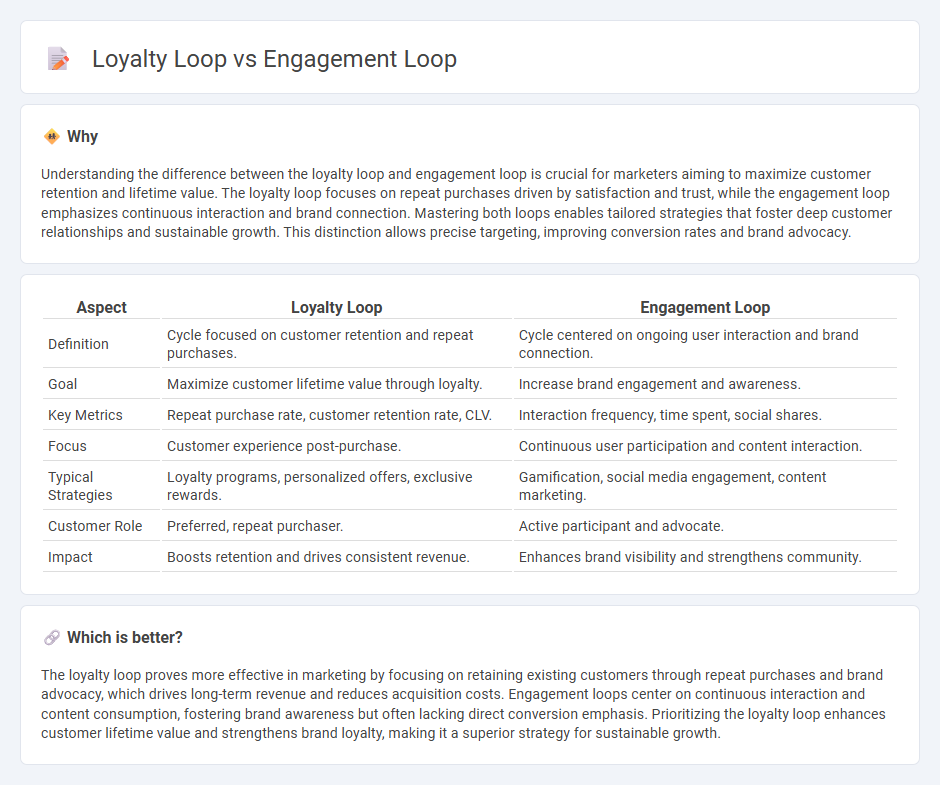
The loyalty loop focuses on transforming satisfied customers into repeat buyers by fostering brand trust and consistent positive experiences, while the engagement loop emphasizes ongoing interaction and deeper connections through personalized content and community building. Both strategies aim to cultivate long-term relationships but differ in approach: loyalty loops prioritize retention, whereas engagement loops drive active participation. Explore these concepts further to enhance your marketing strategy effectively.
Why it is important
Understanding the difference between the loyalty loop and engagement loop is crucial for marketers aiming to maximize customer retention and lifetime value. The loyalty loop focuses on repeat purchases driven by satisfaction and trust, while the engagement loop emphasizes continuous interaction and brand connection. Mastering both loops enables tailored strategies that foster deep customer relationships and sustainable growth. This distinction allows precise targeting, improving conversion rates and brand advocacy.
Comparison Table
| Aspect | Loyalty Loop | Engagement Loop |
|---|---|---|
| Definition | Cycle focused on customer retention and repeat purchases. | Cycle centered on ongoing user interaction and brand connection. |
| Goal | Maximize customer lifetime value through loyalty. | Increase brand engagement and awareness. |
| Key Metrics | Repeat purchase rate, customer retention rate, CLV. | Interaction frequency, time spent, social shares. |
| Focus | Customer experience post-purchase. | Continuous user participation and content interaction. |
| Typical Strategies | Loyalty programs, personalized offers, exclusive rewards. | Gamification, social media engagement, content marketing. |
| Customer Role | Preferred, repeat purchaser. | Active participant and advocate. |
| Impact | Boosts retention and drives consistent revenue. | Enhances brand visibility and strengthens community. |
Which is better?
The loyalty loop proves more effective in marketing by focusing on retaining existing customers through repeat purchases and brand advocacy, which drives long-term revenue and reduces acquisition costs. Engagement loops center on continuous interaction and content consumption, fostering brand awareness but often lacking direct conversion emphasis. Prioritizing the loyalty loop enhances customer lifetime value and strengthens brand loyalty, making it a superior strategy for sustainable growth.
Connection
The loyalty loop and engagement loop are connected through their focus on maintaining continuous customer interaction to drive repeat business and brand advocacy. The engagement loop uses personalized touchpoints and feedback to deepen emotional connections, which feeds into the loyalty loop by encouraging sustained customer retention and repeat purchases. Both loops integrate behavioral data and satisfaction metrics to optimize marketing strategies that foster long-term customer relationships.
Key Terms
**Engagement Loop:**
The Engagement Loop centers on creating a cycle where users interact with a product or service through triggers, actions, rewards, and investments that increase their involvement and frequency of use. This loop harnesses behavioral psychology to build habits by encouraging consistent engagement and repetitive user actions. Explore how mastering the Engagement Loop can significantly boost user retention and product success.
Interaction
Engagement loops emphasize continuous user interaction through targeted touchpoints, fostering active participation and repeated use of a product or service. Loyalty loops concentrate on cultivating customer trust and emotional connection by rewarding consistent behavior, enhancing long-term retention. Explore how strategic interaction designs differentiate engagement and loyalty loops for maximizing user commitment.
Feedback
The engagement loop centers on capturing user feedback to continuously refine product experiences and boost interactivity, while the loyalty loop emphasizes consistent satisfaction through feedback-driven improvements to foster long-term customer retention. Feedback acts as the critical data point enabling both loops to adapt and evolve, ensuring personalized engagement and sustained brand loyalty. Explore how integrating feedback mechanisms can transform your customer journey and maximize retention impact.
Source and External Links
How to Keep Users Coming Back With Engagement Loops - This article discusses how engagement loops work by motivating users with sequences of motivation, action, and feedback to ensure continued engagement.
How to Use 'Engagement Loops' to Grow Your Brand & Business - The article explains how engagement loops can be used to keep audiences connected with a brand across different platforms, enhancing visibility and audience engagement.
The Three Games of Engagement - This publication delves into the concept of engagement loops as part of a broader strategy for user engagement, exploring ways to maintain customer interaction with digital products.
 dowidth.com
dowidth.com